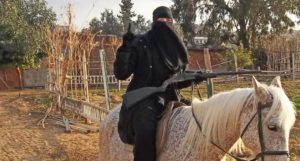When two young men embellish a Toulouse FC replica shirt with the name of the city’s most notorious mass murderer, is it just a sick and provocative gag, or evidence of sympathy for the killer’s worldview? Earlier this month, the French courts decided it was “terrorism apologia” and handed out three and four-month sentences to two men who, posted a photo on Snapchat wearing a football shirt with the name of the delinquent jihadist, Mohammed Merah, across it, with the number seven — for the number he killed.
Mohammed Merah began his rampage in Toulouse on March 11, 2012, first executing a French-Moroccan paratrooper who nobly refused an order to lie down. He struck again on March 15, firing on three soldiers in Montauban — two were killed and another left paralysed. The murdered soldiers were all of North African Muslim descent. Then, on March 19, Merah pulled up outside the Ozar Hatorah Jewish school. In the schoolyard, he gunned down a Rabbi before executing the man’s three and five-year-old sons as they tried to crawl to safety. He then entered the school and grabbed an eight-year-old girl, at which point his gun jammed. Unperturbed, he swapped weapons and shot her. He filmed it all. After a manhunt and lengthy standoff, Merah was shot dead by police at his apartment.
Even considering the usual moral squalor of jihadist violence, Merah’s spree stands out for its depravity. Yet, for some reason, he is still widely revered. Nicole Yardeni, a deputy mayor in the city, tells me that his name is sometimes viewed positively even outside of jihadist circles, as “a symbol of rebellion” against society. After all, Merah is the man “who brought France to its knees”, as one local youth reminded the mother of his first victim. Even at the time of the police manhunt and siege, Facebook posts and pages honouring the gunman attracted thousands of likes, while police prevented people from laying flowers at his apartment. (It goes without saying that the overwhelming majority, Muslim and non-Muslim, were horrified.)
Within Salafi-jihadist circles, Merah’s cold-blooded rampage made him an icon. At the time of his attack a petty criminal, 28-year-old Mehdi Nemmouche, was killing time in a prison cell. Ordinarily, he would have refused to watch infidel television, but this time he asked his guards for a TV set so he could jubilantly follow the Merah manhunt live. Nemmouche would later head for Syria where he became a jailer for Islamic State. Chillingly, he told a captive that, like Merah, he “dreamed of grabbing a Jewish girl by the hair and shooting her dead”. Nemmouche would go on to deliberately target and murder Jews, killing four at Brussels’ Jewish Museum in 2014. It was Europe’s first attack by an Isis returnee.
Merah told police that he had conducted his attack on behalf of al-Qaeda, but that has not stopped their bitter Islamic State rivals from invoking his name. Journalist David Thomson interviewed several French members of Isis, each one praising Merah. Even official Isis propaganda has urged Francophone supporters to follow in Merah’s footsteps.
Laurence Bindner, who co-founded Jihadoscope to monitor jihadi online activity, tells me that Merah’s impact on the ground in his Cité des Izards housing estate “has been profound”. To Bindner, Merah’s place in jihadi lore is symbolic for a simple, gruesome reason: “He was the one who has no limits, the one who kills children.” But, she quickly adds, “this also put him beyond the pale even for some radical Islamists”. Merah was the first to cross a line.
Merah’s act divided Salafi-jihadists in France and beyond. But for the next few years, his supporters seemed to be winning the argument, and decisively so. The Merah generation wanted to transform Europe’s streets and plazas into the new theatres of jihad. In doing so, they helped unleash a campaign of extreme violence against European civilians with France — very deliberately — at the centre. Merah and his imitators shattered the illusion that France, by virtue of not participating in the Iraq invasion, would be spared the terror which had struck in Madrid and London in the years prior. Following in Merah’s footsteps, this generation had few qualms about the massacre of children, from Nice’s Promenade des Anglais to the foyer of Manchester Arena.
Perhaps the most damaging myth that Merah created was that of the loup solitaire — the lone wolf. It was deployed in Merah’s case to underline that he had acted alone and not received formal direction from al-Qaeda, but these were the old rules of counter-terrorism not yet updated for European jihad’s coming of age. Security services anticipated clandestine cells and bombings of “high value” targets and infrastructure; what they got was a bottom up wave of often intimate mass casualty violence, and trained extremists with EU passports dispatched across borders from a terror state on Europe’s doorstep. The lone wolf framing prevented the state and civil society from fully realising what was coming, and it obscured the extremist socialisation processes quietly taking place in certain locales around Western Europe.
Some of those affected locales were in Toulouse, where decades ago militants connected to Algeria’s Groupe Islamique Armé (GIA) helped to construct a key node of French jihadism — a milieu where Mohammed Merah belonged. A mentor to Merah was the Syrian “white emir” Olivier Corel, who established a cult-like Salafi-jihadist commune in the countryside. Other Merah associates included the notorious Clain brothers, whose activism helped to swell the ranks of Toulouse’s extremist circles from a few dozen to a few hundred. In the 2000s, this network dispatched extremists to fight against the Americans and the Shia with al-Qaeda in Iraq.
Merah was no black sheep: his extended family nurtured an intense hatred of French society and Jews. His own brother, nicknamed locally after Osama Bin Laden, is thought to have joined the jihad in Iraq. His sister Souad was active in militant Salafist networks. She was part of an independent school established to raise model Muslims as defined by Salafists and the Muslim Brotherhood — whose ideas had cross-pollinated in the densely populated housing estates. Souad, who declared she was “proud, proud, proud” of her brother for massacring Jews would, like so many of Merah’s associates, eventually join Isis. Meanwhile, Merah’s stepbrother was the only Frenchman formally accused of crimes against humanity for his role in the Yazidi genocide.
Merah’s killing spree also triggered a debate on the apparently unique susceptibility of petty criminals and gangsters to jihadism. And though it may well be true that the brutality was attractive to those already inured to violence and seeking status or redemption, this view fails to consider the bigger picture. In France, certain neighbourhoods once in the grip of gangs were slowly taken over by the muscular evangelising of Salafi activists and Islamists, a process facilitated by the isolation, urban density and absence of authority in the Cités. In some locales, the Salafi activists steered people away from crime towards militant religion, in others — like in Toulouse — they incorporated the drug trade into their activism and saw no contradiction between the two. Examining the housing blocks explicitly targeted by this aggressive proselytising programme, it is perhaps less surprising that many petty criminals eventually filled the ranks of Isis.
Merah’s impact on the jihadist movement and European counter-terrorism was profound, but so was his impact on Toulouse. I briefly moved to the city in the aftermath of the rampage, and the attack seemed to loom over its residents. It also weighed heavily on Toulouse’s Jewish community, as Yardeni, who headed a Jewish organisation before joining the mayor’s office, estimates that hundreds of families took the impossible decision to leave. Perhaps it was not just the cruelty of Mohammed Merah’s killing spree that made Toulouse’s Jews reconsider, but the knowledge that, to a small number of their neighbours, this act made him a hero.
Disclaimer
Some of the posts we share are controversial and we do not necessarily agree with them in the whole extend. Sometimes we agree with the content or part of it but we do not agree with the narration or language. Nevertheless we find them somehow interesting, valuable and/or informative or we share them, because we strongly believe in freedom of speech, free press and journalism. We strongly encourage you to have a critical approach to all the content, do your own research and analysis to build your own opinion.
We would be glad to have your feedback.
Source: UnHerd Read the original article here: https://unherd.com/



